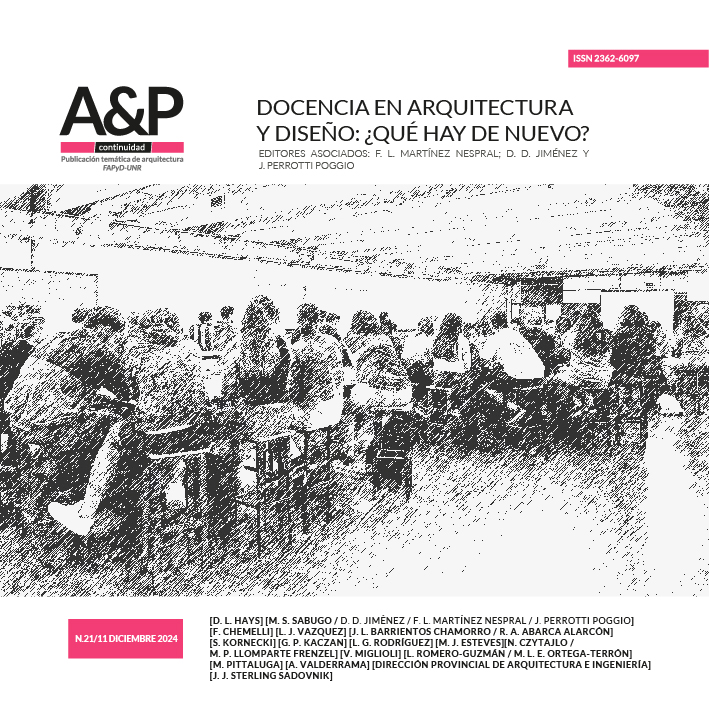Teaching, digital era and artificial intelligence in architecture and design
DOI:
https://doi.org/10.35305/23626097v11i21.490Keywords:
architecture, teaching-learning process, artificial intelligence, generative artificial intelligenceAbstract
This paper discusses the meaning of digital innovations integration in the teaching-learning process in architecture as a challenge characterizing the present century and the new digital era. The aim is to show how the digital era is transforming the teaching-learning process in design and architecture through the educational narrative based on what both students and teachers report, dialogue and argue.
Our concern is to understand the way and the reasons for which artificial intelligence (AI), generative artificial intelligence (GAI), problem-based learning (PBL) and collaborative learning (CL) become concepts contributing to the innovation of the learning-leaching process in design and architecture. In this sense, the diverse institutional administrative areas must promote and provide the legal means for privacy, ethics and access to technology that encourage the above-mentioned processes.
Downloads
Metrics
References
Antler. (2022, diciembre 20). Mapping the generative AI landscape. Insights. Recuperado de https://www.antler.co/blog/generative-ai
Bermúdez Mendieta, J. (2021). El aprendizaje basado en problemas para mejorar el pensamiento crítico: revisión sistemática. Innova Research Journal, 6(2), 77-89, doi: https://doi.org/10.33890/innova.v6.n2.2021.1681
Cabo, D. L. (s.f.). La narrativa del modelo empresarial: clave para ejercer el liderazgo social. Telefónica. Recuperado de https://www.telefonica.com/es/sala-comunicacion/blog/la-narrativa-empresarial-como-clave-para-el-liderazgo-social-el-caso-wayra-telefonica/
Estatuto Universitario de la Universidad Autónoma del Estado de México (2020, diciembre 11). Título Tercero De la Academia Universitaria. Capítulo I De la Docencia Universitaria. Gaceta Universitaria, Núm. Extraordinario, Diciembre 2020, Época XV, Año XXXVI. Toluca, México. Recuperado de https://oag.uaemex.mx/normatividad/phpoffice/pdf/estatuto/ESTATUTO.pdf
González, G., y Díaz, L. (2005). Aprendizaje colaborativo: una experiencia desde las aulas universitarias. Educación y Educadores, 8(1), 21-44. Recuperado de https://www.redalyc.org/articulo.oa?id=83400804
Higher Ed Dive. (2024, enero 10). The AI revolution in higher education. Higher Ed Dive. Recuperado de https://www.highereddive.com/news/ai-white-collar-work-colleges-daniel-susskind-hlc-conference-2024/713654/
IA abierta. (2023). Gemini (versión del 6 de diciembre, 2023) [Modelo de lenguaje grande]. Recuperado de https://gemini.google.com/app/a10487ad5485582a
Iberdrola (2024). ¿Qué es la Inteligencia Artificial? Recuperado de https://www.iberdrola.com/innovacion/que-es-inteligencia-artificial
Internet Live Stats. (s.f.). Internet users in the world. Recuperado de https://www.internetlivestats.com/
INEGI-IFT. (2023, 19 de junio). Encuesta nacional sobre disponibilidad y uso de tecnologías de la información en los hogares (ENDUTIH) 2022. Comunicado de prensa N°367/23. Recuperado de https://www.inegi.org.mx/contenidos/saladeprensa/boletines/2023/ENDUTIH/ENDUTIH_22.pdf
Isola, N. J., y Sáenz, C. A. (2022, 1 de octubre). La evolución en las organizaciones. El valor de la narrativa en el liderazgo. La Nación. Recuperado de https://www.lanacion.com.ar/economia/negocios/la-evolucion-en-las-organizaciones-el-valor-de-la-narrativa-en-el-liderazgo-nid01102022/
Kaizen Networks. (s.f.). 10 tecnologías de inteligencia artificial para 2019. Blog. Recuperado de https://kaizennetworks.es/10-tecnologias-inteligencia-artificial-2019/
Kellner, D. (2002). Teorizando la globalización (Theorizing globalization). Sociological Theory, 20(3), 285-305. Recuperado de http://www.jstor.org/stable/3108613
Martínez P., F. (2020, 18 de julio). ACADERC (Academia Nacional de Derecho y Ciencias Sociales de Córdoba). Recuperado de http://www.acaderc.org.ar
McCulloch, W. S. y Pitts, W. (1943). A logical calculus of the ideas immanent in nervous activity. Bulletin of Mathematical Biophysics, 5, 115-133.
Project Voice. (2023, abril 24-26). Project Voice 2023: The world of conversational AI. Recuperado de https://www.projectvoice.ai/conversational-ai-industry-landscape-map
Puertas, E. (2023). Inteligencia artificial generativa. En UEM STEAM Essentials. Recuperado de http://projectbasedschool.universidadeuropea.es/escuela/escuela/steam_essentials
Rodríguez, M. S. (2022). Diseño industrial e inteligencia artificial (DIIA). En G. I. Garmendia Ramírez (Ed.), De los métodos y las maneras (pp. 81-92). Ciudad de México, México: UAM-Unidad Azcapotzalco.
Senabre C, P. (2023, 30 de junio). McKinsey y su informe sobre la IA generativa. LinkedIn. Recuperado de https://www.linkedin.com/pulse/mckinsey-y-su-informe-sobre-la-ia-generativa-pablo-senabre-catal%C3%A1/?originalSubdomain=es
Statista Research Department. (2024, 5 de marzo). Distribución porcentual de los usuarios de redes sociales en México, en enero 2024, por edad y género. Recuperado de https://es.statista.com/estadisticas/1139347/distribucion-redes-sociales-usuarios-edad-genero-mexico/#:~:text=En%20enero%20de%202024%2C%20casi,el%20pa%C3%ADs%20durante%20ese%20periodo
Telefónica. (2023, 31 de octubre). ¿Qué es la inteligencia artificial generativa? Recuperado de https://www.telefonica.com/es/sala-comunicacion/blog/inteligencia-artificial-generativa/
Trinidad, F. (2014, 5 de octubre). Historia y significado del escudo de la UAEM. Criterio Noticias. Recuperado de https://criterionoticias.wordpress.com/2014/10/05/historia-y-significado-del-escudo-de-la-uaem/#:~:text=En%201920%2C%20el%20instituto%20abandon%C3%B3,dotaba%20de%20un%20car%C3%A1cter%20laico.
UNESCO (2013). Universalidad de Internet: un medio para crear sociedades del conocimiento y la agenda de desarrollo sostenible después de 2015. Recuperado de https://wayback.archive-it.org/10611/20170508213311/http://www.unesco.org/new/fileadmin/MULTIMEDIA/HQ/CI/CI/pdf/news/internet_universality_es_01.pdf
b-LATAM. (2023). Conoce a los 15 top creadores digitales de México. Recuperado de https://2btubelatam.com/los-top-15-creadores-digitales-de-mexico-y-las-tendencias-de-contenidos-para-el-2024/

Published
How to Cite
Issue
Section
License
Copyright (c) 2024 A&P Continuidad

This work is licensed under a Creative Commons Attribution-NonCommercial-ShareAlike 4.0 International License.
Open access policy
A&P Continuidad is a non-profit and open access publication. According to Mexico Declaration on Cultural Policies, the journal distribution is submitted to Creative Commons Attribution-Noncommercial-ShareAlike 4.0 International Public License (CC BY-NC-SA). “Neither the commercial use of the original work nor that of the possible derivative works are allowed. The distribution of derivative works should be submitted to the license regulating the original work. This license is not free.”
A&P Continuidad authorizes the partial or full reproduction of texts and graphs provided that the source is cited. Authors are exclusively responsible for the criteria expressed in the articles which do not necessarily reflect the opinion of the Editorial Committee or that of the Direction Board. The copyright of the published articles pertains to their authors or publishers.
Transfer of rights
The acceptance of an article to be published implies the author’s transfer of rights to the journal. Authors continue to have the right to use the material in future books or publications, approve or veto the republication of their works as well as the rights related to patents or other rights. Transfer of rights form may be downloaded here.























 This OJS site and its metadata are under a
This OJS site and its metadata are under a 

